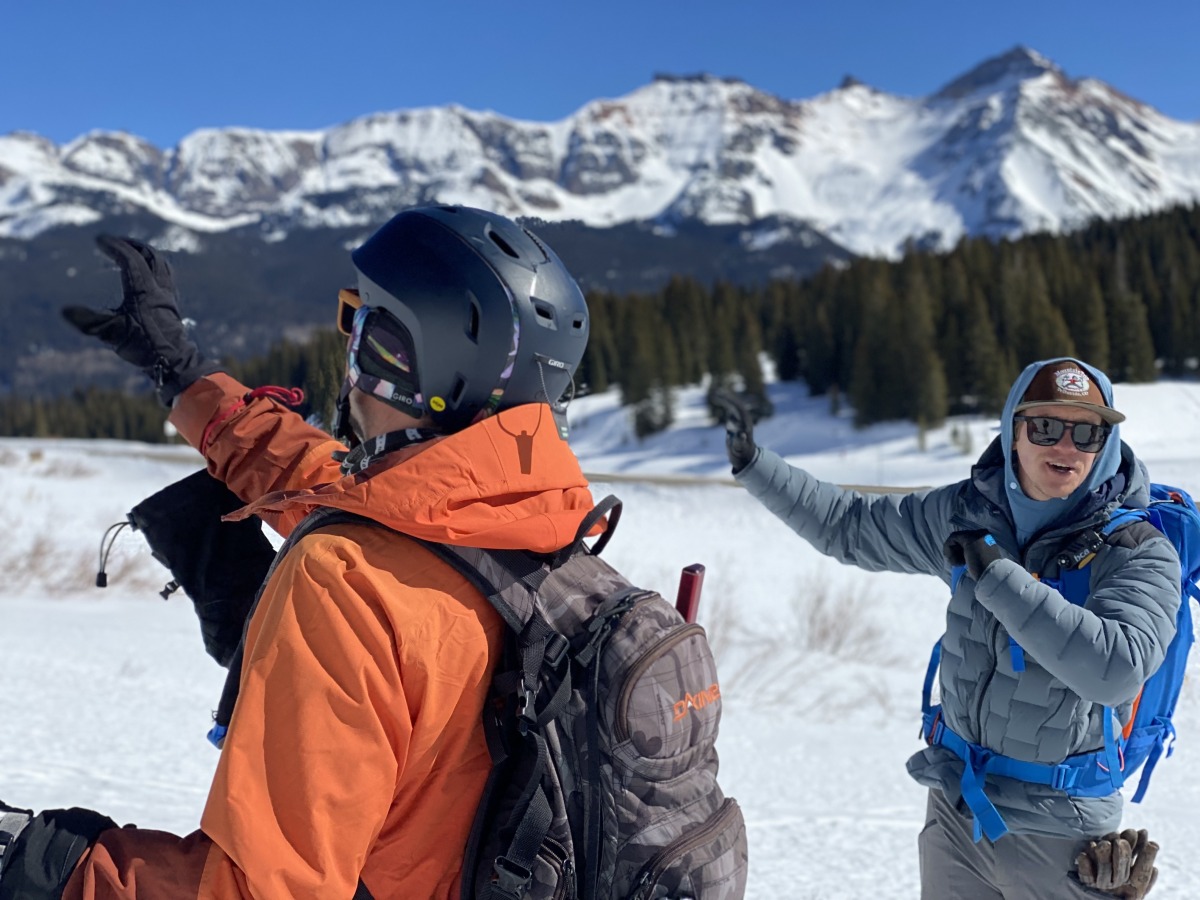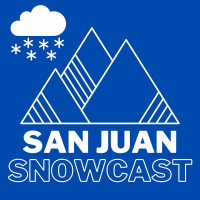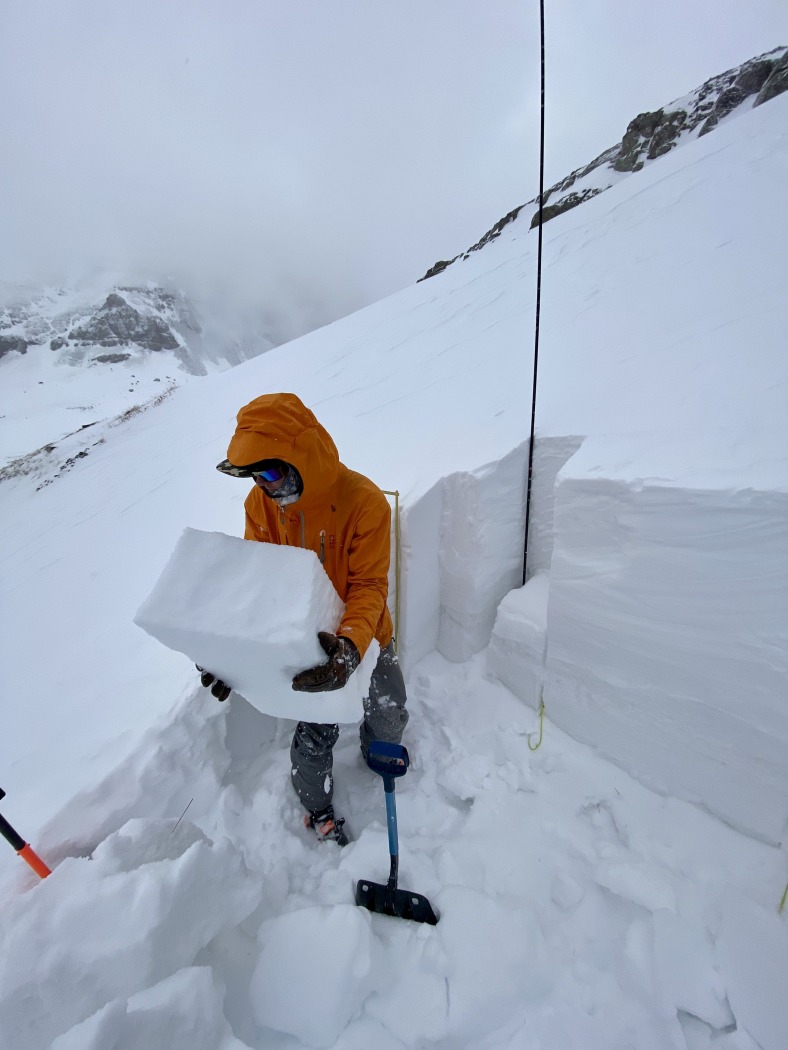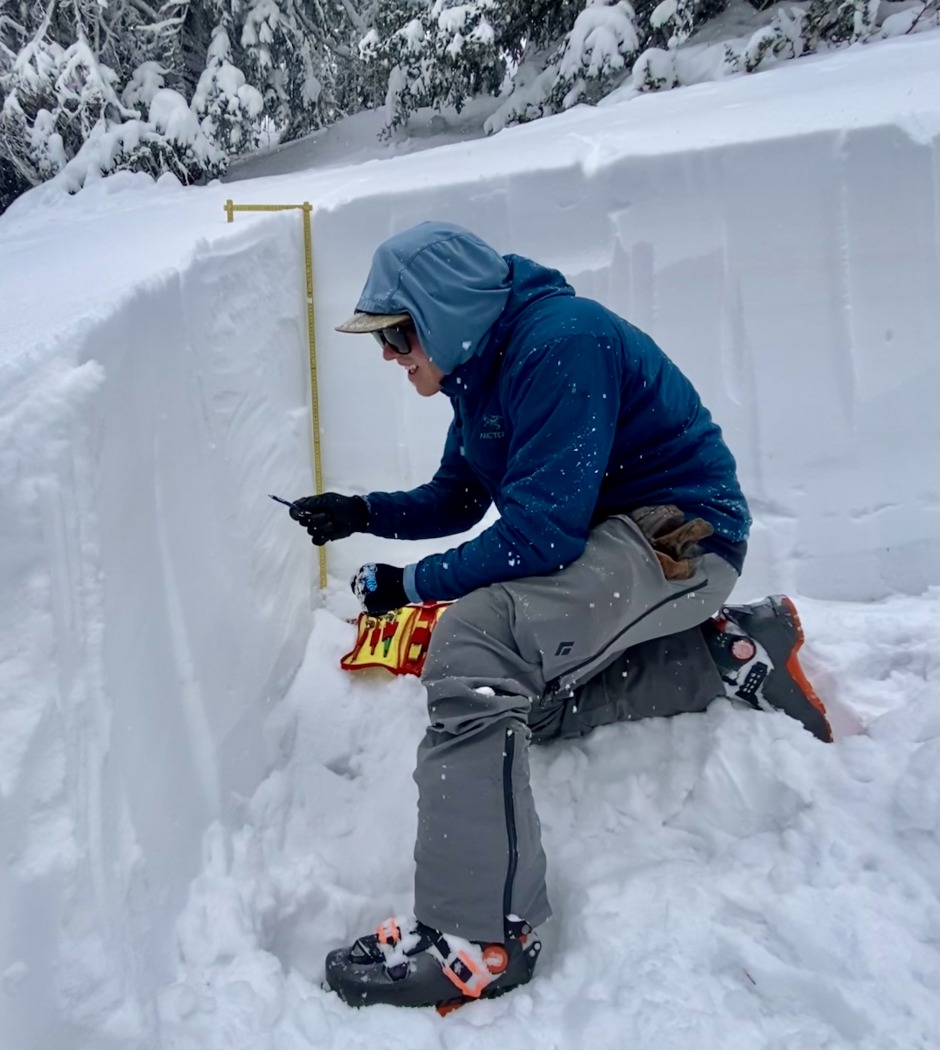
When not producing the hyperlocal podcast, the San Juan Snowcast, Chris Dickson is a full-time avy educator and guide.
Hyperlocal comes to the realm of disseminating information about snowpack, weather, and the mish-mash of conditions we may dive into when assessing snow safety before heading into the field. Chris Dickson is the voice and production/editing team behind the San Juan Snowcast, “Your local source for current snow and avalanche conditions in southwest Colorado,” as the podcast’s tagline states.
The concept of hyperlocal has a place in the winter backcountry realm, where the idea of spatial variability of the snowpack keeps us honest. The hand shear tests, snow pits, and simple observations with your eyes and ears can shape-shift even in micro portions of a ski line. Maybe that’s hyper-hyper local.

What Dickson does is bring a hyper-local perspective from his base in Ophir. As a passionate avalanche educator, he also possesses a keen sense of how people digest that information. Dickson primarily wants his local snowpack information to be accessible and relatable. And his chosen medium is podcasting. The San Juan Snowcast mixes technical snowpack-speak and a down-to-earth message aiming to educate, not proselytize. That combo has much to do with Dickson’s self-effacing tone and production style, as anything else. Living a ways away from the San Juans, with a much different snowpack (East side of the Cascades) I still find Dickson offers nuggets. He also provides a mode of information input that suits auditory learners.
What I like most about Dickson’s approach is his presentation of key information that is often part of an avalanche center’s forecast discussion. I love reading forecast discussions from different regions. I get a good sense of avy-center culture, at least how it is presented digitally, by reading, what I consider, to be the long-form content produced by avy forecasters.
A reader comment on Alex Lee’s story, “20% Chance of Snow…and Avalanches: The Challenge of Forecasting,” caught my attention. The comment was written by Jerry Johnson, a professor at Montana State University.
It read: “Another quick observation is that one reason people do not get from the forecast what we think they ‘should’ is the overuse of icons, roses, graphics, etc. as they encourage rapid scanning – especially on cell phones. How about testing the efficacy of good old fashioned narrative as the primary forecast – some of this is a simple reordering of how the information is presented. That model was not tested in the project referenced. As an example you might visit the Gallatin Avalanche Center site: https://www.mtavalanche.com/forecast. My thinking is that sometimes old school is better.
“Related to that point is the clutter of sponsors and extraneous noise on some sites – how do you expect people to concentrate if they are being lured away with flashy ads? Someone should look at the click data on those sites and see how many people get sidetracked.”
My intent here in recognizing this comment is not to knock avy centers; its to acknowledge that the good information presented on many sites, for various reasons, might never be absorbed by users. And, further, I am not advocating for Dickson’s podcast to be a replacement for anyone trying to gain insight on the San Juan’s snowpack who might otherwise read their local forecast discussion—please read the local forecast discussion. However, the San Juan Snowcast is a resource that can supplement one’s understanding of the San Juan specific backcountry environment they are about to enter—but from a macro sense: Dickson is not out in the field with you making real-time observations.
Despite Dickson’s hyper-local approach, I’m writing about it here on WildSnow because his podcast (and social media posts) is just one more example of a resource that might help skiers make more informed decisions. And to boot, Dickson provides a weekly “knowledge nugget.” On the March 16th episode, the “knowledge nugget” focused on the inner workings of what happens when you hit SOS on an inReach.
(There are several podcast options out there focusing on avalanches.)
What follows is Q & A with Dickson from an interview conducted a few weeks ago, back in February. The interview has been lightly edited for length and clarity. The San Juan Podcast is released weekly, on Wednesdays.

Chris Dickson, producer and host of the San Juan Snowcast, takes his observations from the field and mixes that in with his personal vibe on the San Juan Snowcast, a hyperlocal podcast about…San Juan snow.
WildSnow: One thing I’m interested in is discussing the idea of disseminating information about snowpack, and using a podcast to do that. It’s like micro news services, like small communities have their own independent news service that speaks to the community. But first, let’s get some background.
Chris Dickson: I live in Telluride, Colorado, and I’ve lived here for about eight years. I grew up in Massachusetts, in a super small town in Central Massachusetts; Bolton is the name of the town.
WildSnow: Telluride can be a tough place for people to settle, especially young people.
CD: You know, the classic story of Telluride is you fall in love with the community, then you realize there’s nowhere for you to live here. Right? So I actually live in Ophir, which is a small town outside of Telluride. It is a backcountry mecca. In this case, I just moved closer to the trailhead, which is pretty awesome.
For work, I’m a full-time avalanche educator and ski guide in the winter. That’s all I really do, plus the podcast. I also just took on the role of director of a local nonprofit that tries to increase our community’s backcountry awareness and Avalanche education opportunities. So I figured it fit right in with everything else I got going on.
WildSnow: Here’s a basic question, how would you describe the podcast to people who might be new to it?
CD: It’s a weekly snapshot of what’s going on in the sky and on the ground in the San Juan Mountains of Southwest Colorado. That’s my tagline, if you will. And really, I see it as kind of some bonus content in addition to what we get from the professionals at CAIC (Colorado Avalanche Information Center). I’m just trying to offer a community-based viewpoint of the snowpack, the avalanche conditions, and trying to highlight some local data for folks. But it’s a fine line between giving information that I hope will help people make better decisions, but not telling folks where I think they should go skiing. There’s a lot of liability in that. I want to leave that to the CAIC. The professionals. I see my role as a kind of community builder. And folks have responded, saying things like, “wow, I don’t have any backcountry partners, but I now feel part of a community because I listened to this podcast.” And that makes my day.
WildSnow: You are someone with ski boots on the ground in your locale. You’re educating people about avalanche awareness, how to analyze snowpack, how to make good decisions when it comes to data collection, and the human component of decision making. Why did you feel like there was a need to produce content like this in your community?
CD: If you know the San Juans a little bit, you know we’re a huge forecasting zone for the CAIC. And oftentimes, forecasters are living over in Silverton, or possibly down in Durango, and they don’t get over here as often. And really, the snowpack is different here than, say, Red Mountain Pass, Silverton, and Durango, Coal Bank Pass. But more, I was putting a lot of information out there via social media. Things like, here’s what I’m digging, here’s what I’m seeing. And folks were responding to that. I was like, “well, cool, how can I do this in a more legitimate way?” And acknowledging, I just took my pro-two course, and I’m in the industry; I’m working towards becoming a full-time avalanche forecaster. I just wanted to offer more information.
In the San Juans, where we have a sketchy snowpack, we have avalanche fatalities almost every year, and I wondered if more information would make any difference. I decided to put it out there for free, and if people engage with it, then great, and if not, you know, it was a fun project.
But the podcast thing was really interesting. I see it as a creative medium for getting information out there to the public. It wasn’t something I was seeing: there’s a lot of print and digital media out there, you can read that, and that’s super important and valuable. That should be everyone’s first step every morning. I just wanted to offer something a little different and fun and engaging in a different way.
WildSnow: How would you definitively define the area, I’m not going to call it a forecast, but the area you are disseminating information about?
CD: I do my best to cover the whole range—trying to unite these little individual backcountry communities of Telluride, Silverton, Durango, Ridgway, Ouray. I’m Ophir-based, and obviously, that’s my bias. I talk a lot about the North San Juans first, and then I get to Durango, what’s going on down by Wolf Creek Pass, and things like that. I hope that everyone in the San Juans can get on board.
It’s interesting, though; 25% of my listeners are from Denver. They’re folks who want to recreate here occasionally, and they want to be in tune with what’s going on and have their finger on the pulse a little bit down here. And then a big part of the podcast, too, is snowpack, weather updates, and then an avalanche education nugget. And that can be something about online mapping, emergency preparedness, picking a good backcountry partner, all the different mindsets you can have in the backcountry. So that stuff is definitely more universal.
WildSnow: How do you see the podcast complementing what might be on an avy forecast website, in particular, the pieces on a website that might be critical, that are more nuanced, if that makes sense?
CD: The feedback I get is that folks appreciate the deep dive. Some folks are like, “wow, I hear what you’re saying, and I don’t understand half of it because I’ve just taken my level one course.” And other folks are like, “Oh, this is really cool. I’m getting a more nuanced in-depth take on some of this stuff.”
I think what you’re getting at is just hitting people with lots of different mediums. We talk about visual learners, auditory learners: if we can find a way that gives them information and a bunch of different mediums, I think it’s going to lead to, hopefully, some of the information sticking.
I heard this quote from Drew Hardesty of the Utah Avy Center, and he said that a third of the people, only 1/3 of the people, actually click through and read the discussion. So two-thirds of the people see the headlines, the menu items, for example. Then only a third of the people are going in and seeing where the burger is sourced from.
I’m just trying to offer listeners an in-depth look. And for some people, honestly, its a little too much information, or it’s over their head. I try to acknowledge that as best I can. But for other people who have a higher level of understanding, I think some of this info can be engaging. And maybe the different medium gives me a little bit of an edge in trying to get through to some people.
In general, I try to be more conservative than the CAIC, as I’m trying to be careful about the message I put out there and try to tell folks, if anything, just underscoring the message that the professionals are putting out there. I just give it a fun, engaging tilt. It’s different than just reading a page on a website.

Chris Dickson in the office.
WildSnow: I’m curious, have any other people reached out to you and explained that they want something like the SnowCast in their community and asked how I make this happen?
CD: That’s a good question. You know, not yet. But I haven’t found anything quite like this in the snow and avalanche podcast space; there’s The Avalanche Hour with Caleb and other folks. And then there are a few others. There’s The Flakes Podcast, but there’s nothing hyper-regional.
This is a bit of a gamble, putting out something that is regionally focused. Other entities are doing awesome media engagement, like the Crested Butte Avalanche Center, the Utah Avalanche Center. They put out all these excellent videos and multimedia information—I think they are hitting on that in a similar way. The CAIC started doing these weekly forecasts and video updates that Brian Lazar produces: that’s new and engaging to me. Collectively, we’re finding new ways to engage with the audience. But for now, no one else has reached out, asking how I do this?
WildSnow: I’m curious, how do you balance the idea that you provide backcountry skiing information and remind everyone that they’re making their own decisions out there?
CD: I’ve had many people say you really need a disclaimer at the beginning of every show; the liability should be something you’re thinking about at every turn. And I have put a disclaimer in a lot of shows where my biggest fear is someone listening to something I say and interpreting it somehow, and then triggering an avalanche and getting killed. That keeps me up at night, honestly.
I try and make it clear that I’m just another data point. I’m one more piece of information. But I’ve said this a lot on the pod, and I’ll say it again: nothing I say on the podcast, hopefully, convinces you to take on more risk. And so my whole vibe is, if anything, I’m trying to get folks to reduce the risk they take by making people more aware of the actual risk involved in backcountry skiing.
It’s also a two-way street, and each party has to uphold their end of the bargain. The people putting out the information hope that the people on the receiving end are actually listening and reading and absorbing that information. And I think the disconnect is when folks continue to put out the same information thinking, well, we’re putting out good information, and it must be the users that are missing it.
I guess my whole take on that is we just need to get more creative and have empathy for those folks who don’t know how to engage or don’t have the ability to engage, but they are out there doing the activity. It’s a tough one. I think many of the younger folks in this game and, you know, are newer to the game and just want to try more things—maybe it’s a combination of a daily podcast and written bulletin, or more YouTube videos. I think variety is my approach where more varied sources of information lead to better outcomes. But we’ll see. I’m on episode 18. It’s all still kind of unfolding in front of me.
Editor’s note: he’s now published episode 21.
Jason Albert comes to WildSnow from Bend, Oregon. After growing up on the East Coast, he migrated from Montana to Colorado and settled in Oregon. Simple pleasures are quiet and long days touring. His gray hair might stem from his first Grand Traverse in 2000 when rented leather boots and 210cm skis were not the speed weapons he had hoped for. Jason survived the transition from free-heel kool-aid drinker to faster and lighter (think AT), and safer, are better.
